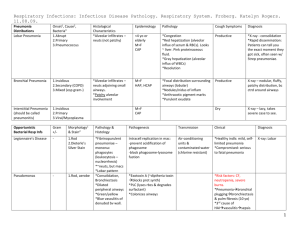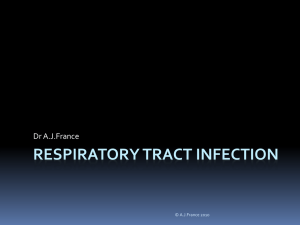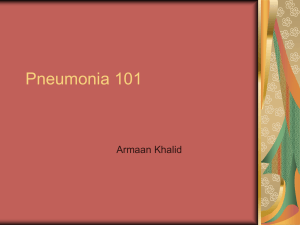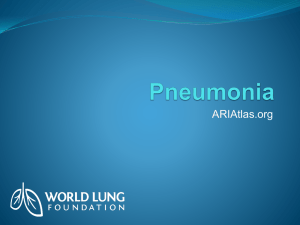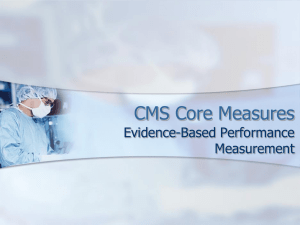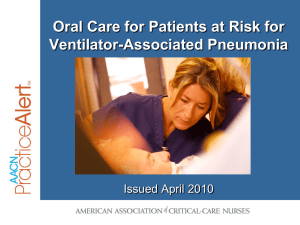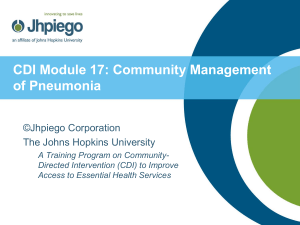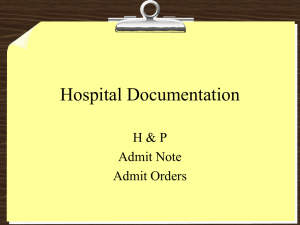5 教改班呼吸系统the lung(一)
advertisement
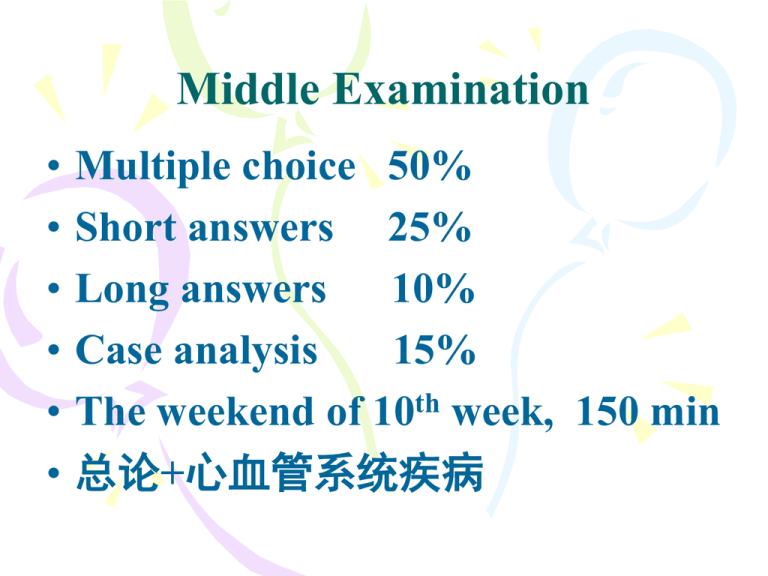
Middle Examination • • • • • • Multiple choice 50% Short answers 25% Long answers 10% Case analysis 15% The weekend of 10th week, 150 min 总论+心血管系统疾病 Chapter 9 Diseases of the Respiratory System Department Of Pathology Guangxi Medical University Zili Lv 吕自力 lvzili@yahoo.com.cn Anatomic Structures and Functions Bronchi Bronchioles Alveolar ducts Alveoli Clinical features of respiratory diseases 1. Cough 2. Sputum Production咳痰 3. Hemoptysis 咯血 4. Dyspnoea呼吸困难 5. Cyanosis紫绀 6. Chest pain Contents (6 hrs) 1. Pulmonary infections 2. Chronic obstructive pulmonary diseases & chronic cor pulmonale 3. Chronic diffuse interstitial lung disease, carcinoma of nasopharynx and lung. Pulmonary infections Acute Pneumonia Chronic Pneumonia Classification of pneumonia Clinical circumstance Primary and Secondary Etiological agent Bacterial, Virus, Fungal Host reaction Fibrinous & Suppurative Anatomical pattern Lobar & Lobular Case 1 analysis History: Male, 20, after suffering from cold and drunk, got high fever, chill, rapid breathing and chest pain. After 2 days, he coughed with “rusty” sputum. T: 40℃, R: 32 times/min. Chest x-ray: show large-area uniform dense well-delimited shadow in his left upper lobe. Blood examination: WBC: 13.5x 109/ L BACTERIUM PNEUMONIA Lobar pneumonia Lobular pneumonia Legionella pneumonia Lobar pneumonia Affects a large part, or the entirety of a lobe Relatively uncommon in infancy and old age Affects males more than females 90% due to pneumococcus (肺炎球菌) Cough and fever with purulent or Rusty Sputum铁锈色痰 A. Etiology Pathogen: Streptococcus pneumonia 肺炎球菌 III型 Infective Route: Inhalation, Aspiration 吸入 Risk Factors: Cold, drunk, tired, diabetes B. Pathology* Acute exudative fibrinous inflammation (急性纤维素性炎) Involves one whole lobe or several lobes The bronchi are not involved Pathologic Features Acute congestion 充血水肿期 Red hepatization 红色肝样变期 Gray hepatization 灰色肝样变期 Resolution 溶解消散期 1. Stage of acute congestion 1st-2nd day (1)Gross changes: Heavy, dark red and firm (2)Microscopic change Fluid, RBC, WBC in the air space (3)Clinical features: Stage of acute congestion Alveolar capillaries: Dilated Air space: Fluid, RBC, WBC Stage of acute congestion Clinical Features Fever, cough, cyanopathy (发绀) Chest pain Bacteremia Bacteria can be found in sputum 2. Stage of Red Hepatization: 2nd-4th day ( ) 1 Grossly • Red and consolidation, just like liver (2)Microscopic changes of red hepatization A. Capillaries congestion B. Exudation: Fibrin, large number of RBC C. Fibrinous pleurisy Microscopical changes (3) Chest x-ray 红色肝样变期X线特点 • The middle segment of right upper lobe become consolidated and show large-area uniform dense shadow. (4) Clinical features of red hepatization Fever, cough, chest pain Rapid breathing, cyanopathy Dullness浊音 Vocal fremitus enhancement 语颤增强 Rusty sputum 铁锈色痰 3. Stage of gray hepatization: 5th-6th day (1)Gross changes of grey hepatization Dry Gray Firm Consolidation (2)Histological changes Capillary is not dilated anymore. Alveolar space is filled with neutrophil and fibrin Histological changes of grey hepatization • (3)Chest x-ray: high dense shadow can X-ray features gray hepatization be found at theofright upper lobe (4)Clinical features of gray hepatization Consolidation: dullness, vocal fremitus enhancement Sputum: mucus purulent sputum Dyspnoea(缺氧): is not obvious 4. Stage of Resolution, 7 days later Gross changes: Friable and mottled Microscope: The fibrin and cell debris are digested by enzymatic, The exudation is remove. Chest X-ray Pathologic Features (4 stages) LOBULAR PNEMONIA 小叶性肺炎 (Bronchopneumonia) (支气管肺炎) Lobular pneumonia Bronchopneumonia Bronchi are infected Patchy consolidation Centred on inflamed bronchioles or bronchi Secondary pneumonia Less virulent agents, in infancy or old age Suppurative inflammation化脓性炎 A. Etiology Pathogen: many bacteria, Infection via: Inhalation, Aspiration Risk Factors: Secondary B. Pathology Gross: Lower lobes, dorsal side Multiple firm areas, around inflamed bronchioles. Microscope: 1. Multiple lesions Purulent bronchitis and bronchiolitis (化脓性细支气管炎) 2. Alveolar spaces surrounding the lesions are filled with neutrophil 3. Compensatory emphysema (代偿性肺气肿) C. Clinical Features The onset is insidious, nonspecific Low-grade fever Dyspnea is not prominent The typical feature is Purulent Sputum脓痰* • Chest xray • Several scattered patchy shadows evidently in bilateral lower lobes Legionella pneumonia, 军团菌肺炎 •嗜肺军团杆菌 •急性纤维素性化脓性 炎—典型病例,严重者 坏死—脓肿 •临床表现复杂:肺内\ 外表现 Legionella pneumonia, 军团菌肺炎 急性纤维素性化脓性炎 acute fibrino-purulent exudative pneumonia 军团菌病(legionaires disease)是由革 兰染色阴性的嗜肺军团杆菌 (legionella pneumophila)引起的一 种以肺炎为主的全身性疾病,1976 年被确认。 Resolution Lobar pneumonia Air space pneumonia Lobular pneumonia Complications Complications of acute air space pneumonia Pleura involvement Bacteremia Suppuration (Abscess Formation) Necrotizing bacterial pneumonia Pulmonay carnification肺肉质变 • Lung abscess • Pulmonary carnification What are the differences? Distribution Number Host reaction Clinical Features Acute interstitial pneumonia间质性肺炎 1. Agents: Virus (SARS, Avian influenza, Swine Flu) and Mycoplasma or Pneumocystis 2. Interstitium 3. Atypical pneumonia 4. Infiltration with lymphocyte, monocyte Pathologic Features of Viral pneumonia The alveolar septa are expanded Cell infiltrate: lymphocyte, plasma cells Air spaces are air filled Epithelial necrosis Inclusion bodies 病毒包涵体 Multinucleated giant cells 多核巨细胞 Hyaline membranes 透明膜 Viral Pneumonia SARS Severe Acute Respiratory Syndrom (SARS) 重症急性呼吸综合征 Atypical pneumonia(非典型肺炎) Cornonavirus 变异的冠状病毒 Extensive consolidation, hyaline membrane, necrosis, pulmonary fibrosis Die in respiratory distress Clinical features Electro microscope Avian Influenza 禽流感 H5N1 Interstitial Atypical 人畜共患传染病 Bird flu An infection disease of birds 1997, Hong Kong, outbreak Vascular disturbances Fever, cough All the other organs can be affected, for example, liver, heart and kidney. H1N1, Swine influenza A H1N1, Swine influenza A 临床表现 轻症:同普通流感;重症:肺炎,坏死性脑病 合并症:急性呼吸窘迫综合征 病理:肺部表现为支气管壁坏死、中性粒细胞 浸润、弥漫性肺泡损害伴肺透明膜病变。 发病机制:病毒损伤肺泡微血管导致肺出血与 血栓形成,体内免疫因子可对抗病毒感染并修 复损伤,但炎症反应过度、渗出液充满肺组织 又使肺瘢痕形成,进而限制肺功能。 H1N1 and H5N1 Mycoplasma pneumonia 支原体肺炎 Interstitial pneumonia Atypical pneumonia Congested, edematous, mononuclear cells infiltration Lobar pneumonia Air space pneumonia Lobular pneumonia Interstitial Viral pneumonia pneumonia Mycoplasma pneumonia ARDS Acute Respiratory Distress Syndrome An acute diffuse alveolar injury Terminal events in many of the patients Serious ill, the mortality rate > 50% Results from ischemic, endotoxins, enzymes. Case 1 analysis History: Male, 20, after suffering from cold and drunk, got high fever, chill, rapid breathing and chest pain. After 2 days, he coughed with “rusty” sputum. T: 40℃, R: 32 times/min. Chest x-ray: show large-area uniform dense well-delimited shadow in his left upper lobe. Blood examination: WBC: 13.5x 109/ L Questions What is the diagnosis? Which type of inflammation? Why does the patient cough with the “rusty” sputum? Half a year later, this student was enrolled to the army. The chest x-ray indicated there was a nodule in his left lung. The nodule was checked under microscope, there was much granulation tissue in the alveolar spaces. WHY? Case abstract 2 Male, 70-year-old, he had suffered hypertensive heart disease and left heart failure for half a year, and cough and expectoration for 1 year. These symptoms aggravated 4 days ago with fever and purulent sputum. T: 38℃, HR: 112 times/min, R: 35 times/min, BP: 22.6/13.5 kPa. Blood WBC: 10.2 X 109/L X-ray: Several scattered patchy shadows evidently in bilateral lower lobes. Questions What is the diagnosis? Which type of inflammation? Why do patients cough with the purulent sputum? Summary How to differentiate the lobar pneumonia and the bronchopneumonia? What is the “rusty sputum”? See you next time! 2015/4/13 79
